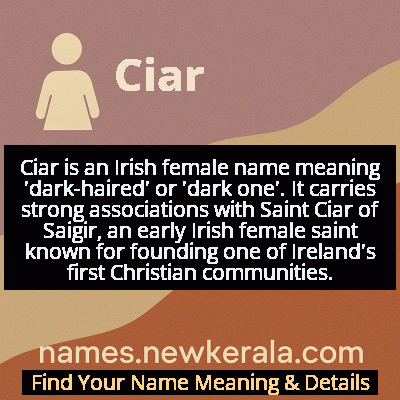Ciar Name Meaning & Details
Origin, Popularity, Numerology Analysis & Name Meaning of Ciar
Discover the origin, meaning, and cultural significance of the name CIAR. Delve into its historical roots and explore the lasting impact it has had on communities and traditions.
Name
Ciar
Gender
Female
Origin
Irish
Lucky Number
4
Meaning of the Name - Ciar
Ciar is an Irish female name meaning 'dark-haired' or 'dark one'. It carries strong associations with Saint Ciar of Saigir, an early Irish female saint known for founding one of Ireland's first Christian communities.
Ciar - Complete Numerology Analysis
Your Numerology Number
Based on Pythagorean Numerology System
Ruling Planet
Uranus (Rahu)
Positive Nature
Strong sense of order, loyal, practical, and disciplined.
Negative Traits
Stubborn, overly serious, rigid, and prone to feeling restricted.
Lucky Colours
Blue, gray.
Lucky Days
Saturday.
Lucky Stones
Blue sapphire.
Harmony Numbers
1, 7, 8.
Best Suited Professions
Managers, engineers, accountants, organizers.
What People Like About You
Dependability, discipline, practicality.
Famous People Named Ciar
Saint Ciar of Saigir
Christian Saint
Founded one of Ireland's first monasteries and Christian communities
Ciar Byrne
Author
Contemporary Irish novelist exploring modern Irish identity
Ciar O'Carroll
Athlete
Multiple All-Ireland medal winner in ladies' Gaelic football
Name Variations & International Equivalents
Click on blue names to explore their detailed meanings. Gray names with will be available soon.
Cultural & Historical Significance
Beyond its religious significance, the name connects to ancient Irish linguistic and cultural traditions. Derived from the Irish word 'ciar' meaning 'dark', it reflects the Celtic practice of naming based on physical characteristics, particularly hair color, which held symbolic importance in early Irish society. The name's survival and occasional modern usage demonstrate the continuing relevance of Ireland's early Christian heritage and the preservation of traditional naming practices that connect contemporary Irish people to their ancient cultural roots.
Extended Personality Analysis
Women named Ciar are typically characterized by a combination of quiet strength, deep intuition, and spiritual depth. They often possess an observant nature, preferring to listen and absorb information before speaking, which gives them insight into people and situations that others might miss. This contemplative quality is balanced by a strong sense of purpose and determination when they commit to a cause or relationship. Their 'dark' namesake meaning often manifests not as negativity but as depth of character – they tend to be complex individuals with rich inner lives and strong personal convictions.
In social settings, those named Ciar may appear reserved initially but reveal warmth and loyalty to those who earn their trust. They often demonstrate natural leadership through quiet example rather than forceful assertion, embodying the saintly qualities of their namesake through service and dedication. There's frequently a creative or spiritual dimension to their personality, with many pursuing artistic, healing, or educational professions. Their combination of introspection and practical action makes them particularly effective in roles requiring both insight and implementation, reflecting Saint Ciar's own balance of contemplative spirituality and community building.
Modern Usage & Popularity
In contemporary naming practices, Ciar maintains a niche but meaningful presence, primarily within Ireland and among families of Irish heritage abroad. While it never reached the widespread popularity of its variant 'Ciara', which saw significant usage internationally in the 1980s and 1990s, Cira persists as a traditional choice valued for its authenticity and historical significance. The name's usage today often reflects deliberate cultural preservation, chosen by parents seeking to honor Irish Christian heritage or looking for names with spiritual depth outside mainstream trends. Its rarity in modern times adds to its appeal for those wanting distinctive yet meaningful names, though it remains considerably less common than many other Irish saint names. The name continues to be associated with regions historically connected to Saint Ciar, particularly in County Offaly, where local devotion maintains the name's cultural relevance.
Symbolic & Spiritual Meanings
Symbolically, Ciar embodies multiple layers of meaning that transcend its literal translation. The 'dark' element represents not absence of light but rather the fertile darkness of soil, the mystery of the unknown, and the depth of wisdom that comes from introspection – concepts highly valued in Celtic spirituality. As a saint's name, it symbolizes spiritual pioneering, feminine leadership in faith, and the establishment of sacred community. The name carries connotations of resilience and cultural continuity, having survived from early Christian Ireland to modern times despite various historical challenges to Irish language and traditions. It also represents the balance between contemplation and action, individual spirituality and community service, reflecting the dual nature of monastic life that characterized early Irish Christianity. The name serves as a symbolic bridge between ancient Celtic culture and Christian tradition, embodying the synthesis that defined early medieval Ireland.

